Related Research Articles
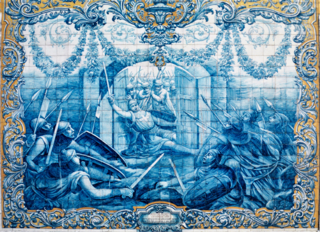
Martim Moniz was a Portuguese knight of noble birth, and famous figure in the Siege of Lisbon in 1147.

Sancho de Tovar, 6th Lord of Cevico, Caracena and Boca de Huérgano was a Portuguese nobleman of Castilian birth, best known as a navigator and explorer during the Portuguese age of discoveries. He was the vice-admiral (soto-capitão) of the fleet that discovered Brazil in 1500, and was later appointed Governor of the East African port-city of Sofala by king Manuel I. In this post, he conducted several exploratory missions in the interior regions of present-day Mozambique.

The Portuguese Naval Aviation constituted the air component of the Portuguese Navy, from 1917 to 1957. The Portuguese Air Force maritime patrol units and the Navy's Helicopter Squadron are the present successors of the former Portuguese Naval Aviation.
Anselmo Fernandez Rodrigues was a Portuguese architect and football manager who led Sporting Clube de Portugal to victory in the UEFA Cup Winners' Cup in 1964 and was the architect of Sporting CP's Estádio José Alvalade inaugurated in 1956.
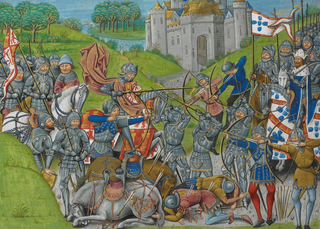
The Fernandine Wars were a series of three conflicts between the Kingdom of Portugal under King Ferdinand I and the Crown of Castile under Kings Henry II and later John I. They were fought over Ferdinand's claim to the Castilian succession after the murder of King Peter of Castile in 1369. After signing the Treaty of Salvaterra there was a period of civil war in Portugal without a ruling king. This was part of the Hundred Years' War.

The naval Battle of Saltes Island or Battle of Saltes took place on 17 July 1381, off Saltes Island, between the Crown of Castile and the Kingdom of Portugal during the Third Ferdinand War. The Castilian fleet commanded by Don Fernando Sánchez de Tovar defeated decisively the Portuguese fleet led by João Afonso Telo. The result of the battle was the destruction of the naval offensive capability of Portugal, achieving the Castilian naval supremacy in the Atlantic Ocean.

The Third Fernandine War was the last conflict of the Fernandine Wars, and took place between 1381–1382, between the Crown of Castile and the Kingdoms of Portugal and England. When Henry II of Castile died in 1379, John of Gaunt, 1st Duke of Lancaster claimed their rights of the throne of the Kingdom of Castile, and found an ally Ferdinand I of Portugal.

The siege of Lisbon was a siege of the city of Lisbon from 29 May to 3 September 1384, between the Portuguese defenders of the city led by John I of Portugal and the Castillian army led by King John I of Castile. The siege ended in a disaster for Castile. A plague outbreak together with the constant attacks by Portuguese forces led by Nuno Álvares Pereira caused huge casualties among the Castilian ranks, who were forced to retreat four months after the start of the siege.
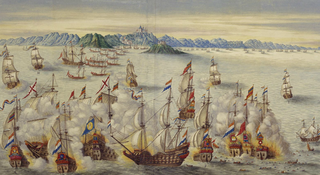
The Battle of Goa refers to a series of naval engagements between the Portuguese Armada and the Dutch East India Company fleets attempting to blockade and conquer the city of Goa. In 1638, forces commanded by the Viceroy of Portuguese India, D. Pedro da Silva and later António Teles de Meneses, fought off a large Dutch fleet sent to block the port colony of Goa, commanded by Admiral Adam Westerwolt, who was badly defeated at this encounter. The next year 1639, the Dutch Admiral Cornelis Simonsz van der Veere would conduct a new raid on Goa's port.
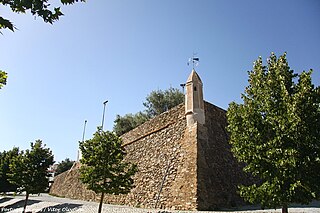
The Castle of Arronches, is a Portuguese medieval castle in civil parish of Assunção, in the municipality of Arronches, in the district of Portalegre.

Augusto Carlos Teixeira de AragãoComA • CavC • CavA • CavTE was a Portuguese officer, doctor, numismatist, archaeologist and historian. As an officer of the Portuguese army, he retired with the rank of general. Teixeira de Aragão is considered one of the "fathers" of Portuguese numismatics.

The Secondary School Luís de Camões is a secondary school located in the civil parish of Arroios, in the municipality and Portuguese capital of Lisbon, classified as a Monumento de Interesse Público in 2012.
The following is a timeline of the history of the city of Lisbon, Portugal.
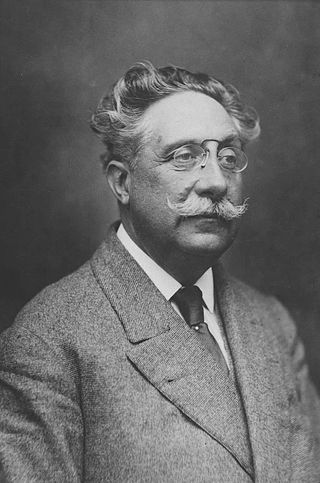
João José Vaz was a Portuguese painter and decorator who specialized in maritime subjects.

The Escola Portuguesa de Arte Equestre is a Portuguese institution dedicated to the preservation of the equestrian arts, in the Portuguese tradition. It is one of the "Big Four", the most prestigious classical riding academies in the world.

Saltes Island is a fluvial islet in the Huelva River estuary, in the province of Huelva, Andalusia, Spain. It is part of the Odiel Marshes biosphere reserve.
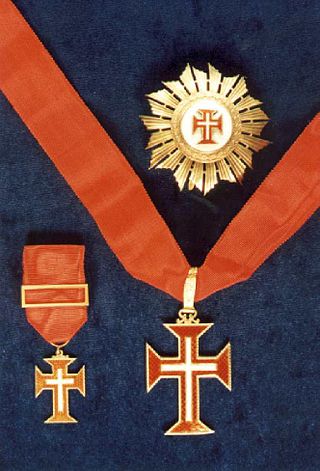
The Ordem Militar de Cristo, the full name of which is the Military Order of Our Knights of Lord Jesus Christ, is a Portuguese honorific Order which takes its name from the extinct Order of Christ (1834), which is given for distinguished service in the performance of functions in sovereign positions or public administration, and for the judiciary and diplomacy, which is seen as being particularly distinguished.

Colégio Militar station is part of the Blue Line of the Lisbon Metro and is located in Lisbon.
The Chaouia Expedition took place in 1487, when a Portuguese force landed at Anfa and pillaged the region between that city and Larache.
References
- Fernão Lopes, Crónica de D. João I, Livraria Civilização, Porto, 1945, Vol. I, pp 233, 239, 244, 250, 254, 256, 259
- Ignacio da Costa Quintella, Annaes da Marinha Portugueza, Academia Real das Sciencias, Lisboa, 1839, Tomo I, p. 45
- Tancredo de Morais, História da Marinha Portuguesa, Clube Militar Naval, Lisboa, 1940, p. 185
- António Rodrigues Pereira, História da Marinha Portuguesa, Escola Naval, Lisboa, 1983, Parte I, p. 147
- Oliveira Martins, Vida de Nun'Álvares, Parceria António Maria Pereira, Lisboa, 1944, p. 202
- Cesáreo Fernandez Duro, La Marina de Castilla, EDITMEX, Madrid, 1995, p. 148
- Joseph Alvarez de la Fuente, Sucession Real de España, Herderos de Francisco del Hierro, Madrid, 1735, Parte Tercera, p. 157